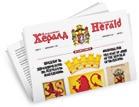The Coats of Arms and Other Forms of State Emblem Proposed for the Republic of Macedonia, and the Process of Their Adoption, 1992–2014
Genealogy 2018, 2(4), 52; doi:10.3390/genealogy2040052
Abstract
:
coat of arms; identity; Macedonian state emblem
1. Introduction
2. The Choice of Symbols of the Republic of Macedonia
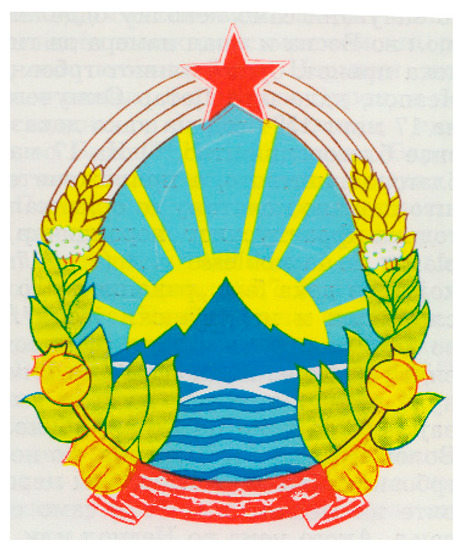
The competition lasted from 25 March until 10 April 1992. Article 3 of the document reads (Службен 1992):
“The proposals for the coat of arms, flag and anthem of the Republic of Macedonia should express the statehood, independence and sovereignty of the Republic, its historical traditions, cultural heritage, the aspiration for social and spiritual progress, the natural characteristics of the Republic, unity and coexistence and the modern aspirations for a democratic society and European and World Integration.”


In the end, the Commission asked the selected designers to submit a further proposal with the same new golden sun on a red field for the arms and for the flag. The proposal submitted under the code “FENIKS 92” (Figure 3b) was accepted and included in the commission’s official Draft Law on the Coat of Arms submitted by the MPs Tito Petkovski, Zoran Krstevski, and Kiro Popovski on 20 June 1992, as well as a proposal for a flag with the same sun. The draft proposal states:
“The coat of arms of the Republic of Macedonia is a shield with a red field enclosed with a yellow (golden) edge. In the middle of the shield is a yellow (golden) sun. The sun has 16 primary rays that break in 32 rays, 16 of which are at the top of the primary, and the other 16 are in the middle between the two primary rays. Under the shield is a ribbon on which is written “Republika Makedonija.”

This coat of arms, Gules crowned lion Or, was the one most often suggested in the process of choosing the arms, accompanied with different inscriptions on the ribbon under the shield:
-
With the text “Makedonija”, in the proposals of Todor Petrov of 1 June 1992; Blagoj Toshev of 31 July 1992; Vladimir Golubovski of 12 August 1992; and, again, Todor Petrov of 17 August 1992.
-
With the text “Republika Makedonija”, in the proposal of Dragi Arsov of 20 June 1992; Aleksandar Florovski et al. of 22 July 1992; and Dragi Arsov of 12 August 1992.
-
With “Macedoniae” in the proposal of Vladimir Golubovski of 7 August 1992.
-
Without any text in the proposal of Todor Petrov of 8 June 1992.
The first proposal by Todor Petrov for the flag had a sixteen-rayed sun, now known as the Kutlesh/Star of Vergina, which eventually received the support of the majority. Then, following the initiative of Todor Petrov on 30 July 1992, an agreement was reached between the political parties for a coat of arms with the same sun with a description (Figure 4b):
The coat of arms of the Republic of Macedonia is a quadrilateral shield with a red field enclosed with a golden-yellow edge. In the middle of the shield there is a golden-yellow sun with eight primary and eight secondary rays, slightly thickened in the first half, intermittently and symmetrically arranged around the solar disk. The basic solar rays are directly detached from the solar disk, and the final outer length of all sixteen sun rays coincides with the outer periphery of the sun.
The diameter of the solar disk is one-sixth of the length of the shield. The ratio of the diameter of the solar disk to the length of the basic solar rays is one to two, and the ratio of the length of the secondary and basic sun rays is seven to eight.
Under the shield there is a red ribbon with a golden-yellow edge on which word “Makedonija” is written with golden-yellow letters.

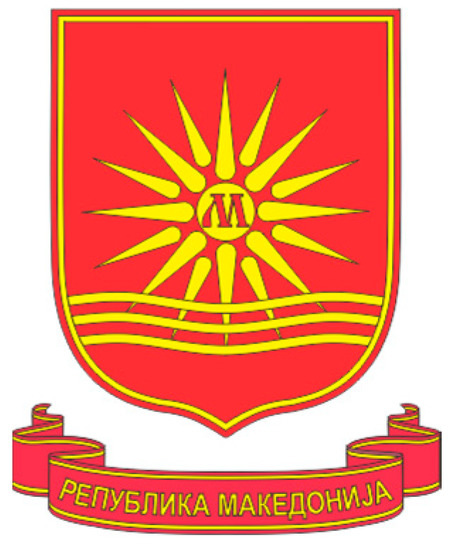
3. Proposals with the Sun after 1992

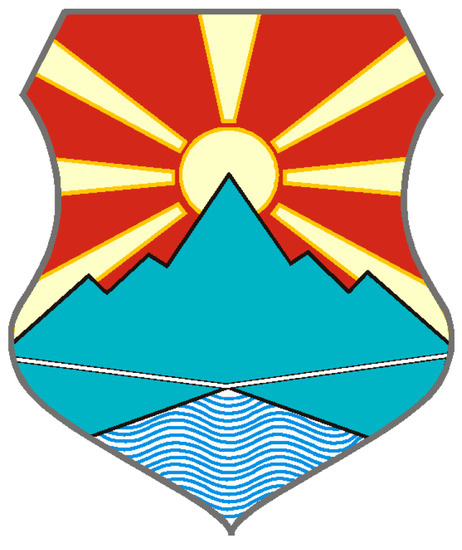
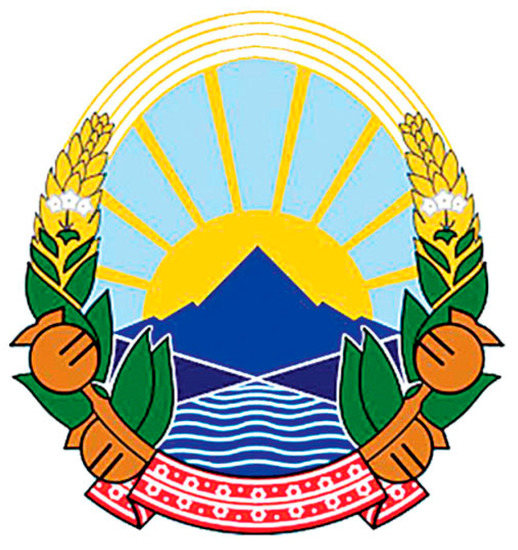
Article 2 of the Law on the Coat of Arms of the Republic of Macedonia describes it this way (Службен 2009):
- (1)
-
The coat of arms of the Republic of Macedonia is a field surrounded by stalks of wheat that connect to the top, intertwined with fruits of poppy and tobacco leaves, which are connected to the bottom with a ribbon embroidered with folk motifs.
- (2)
-
In the middle of the field there is a mountain, and in the foothills a river flows, and the sun rises behind the mountain.
4. Proposals with a Lion
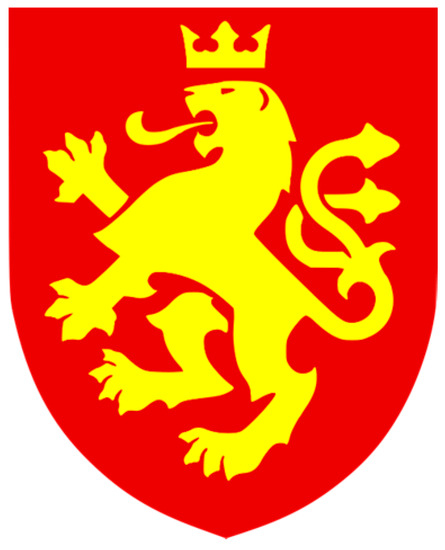
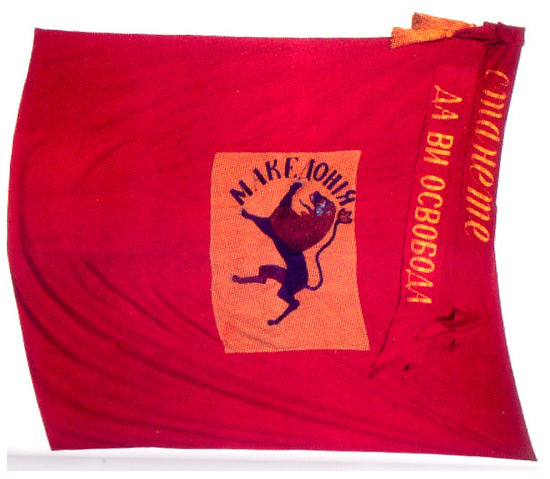
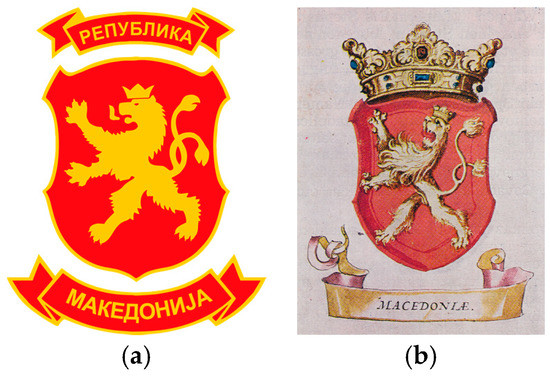
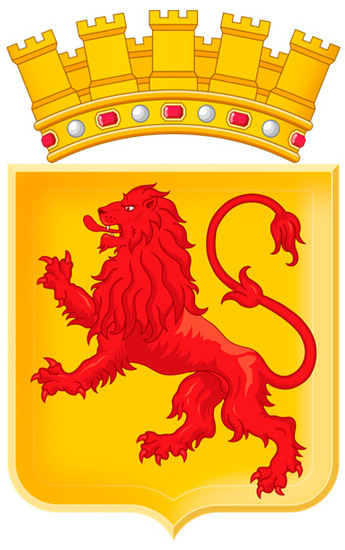
According to a government statement for the media:
The proposal for the coat of arms of the Republic of Macedonia is based on the tradition of coats of arms connected with Macedonia, starting with the illustrations by Willem Verland (+1481) and the Jerome de Bara of 1581, which, through the Stematographias of Vitezovicof 1694 and Zhefarovic of 1741, will become the land arms of Macedonia. In the European armorials, the most consistent representation is the Or lion Gules. The most famous representations are in the armorial of Jerome de Bara of1581 and Jean Roben of 1639, which preceded the Illyrian and originated in European countries with a developed heraldic tradition.
The mural crown on the arms represents the republican arrangement of the state. The towers of the crown represent the graphic expression of the number five which, in turn, is a symbol of statehood. With this, it aims to emphasize and show the sovereignty and integrity of the state. Ruby and pearls are symbols that connect the country with the earth as a natural soil. The lion as a symbol can be seen as unifying by all communities and citizens, because it is a symbol of Macedonians, Albanians, Serbs, Turks, Vlachs, Roma, and other communities, and it represents the land symbol of the country, the territory, the state of Macedonia. It has its own tradition but, also, the present and future of a European Macedonia, which takes care of its past, and also its future, through a symbol that promotes unity and creates unity for all who live in this region, a symbol that brings no division.
5. Conclusions
Funding
Conflicts of Interest
References and Note
- А.Х. 1995. За грбот Оoслободен од идеолошки симболи…. Дело, April 24. [Google Scholar]
- Ацовић, Драгомир. 2008. Хералдика и Срби. Београд: Завод за уџбенике. [Google Scholar]
- Војновска, Оливера. 1998. Ќе биде ли избран новиот грб. Нова Македонија, April 4. [Google Scholar]
- Војновска, Оливера. 2009. Падна петокраката од државниот грб. Утрински весник, November 17. [Google Scholar]
- Cerulo, Karen A. 1995. Identity Designs, the Sight and Sound of a Nation. New Brunswick: Rutgers University Press. [Google Scholar]
- Ćosić, Stjepan. 2015. Ideologija rodoslovlja, Korenić-Neorićev grbovnik iz 1595. Zagreb-Dubrovnik: HAZU, Zavod za povjesne znanosti u Dubrovniku, Nacionalna I sveučilišna knjižnica u Zagrebu. [Google Scholar]
- Службен. 1992. Службен весник на Република Македонија. Skopje: Official Gazette of the Republic of Macedonia, # 19. [Google Scholar]
- Службен. 2009. Службен весник на Република Македонија. Skopje: Official Gazette of the Republic of Macedonia, # 138. [Google Scholar]
- Стенографски. 1992. Стенографски белешки од Првото продолжение на Четириесет и првата седница на Собранието на Република Македонија. одржана на 11 август 1992 година. [Stenographic notes]. [Google Scholar]
- Government Communication. 2014. Available online: http://heraldika.org.mk/heraldry/heraldry-arms/state-coat-of-arms/predlog-nov-grb-republika-macedonia/ (accessed on 6 December 2014).
- Grchev, Miroslav. 2011. In Search of the New Flag. In Macedonian Herald 5. Skopje: Macedonian heraldry Society. [Google Scholar]
- Jonovski, Jovan. 1998. Грб—ослободен од идеолошки елементи. Нова Македонија, April 29. [Google Scholar]
- Jonovski, Jovan. 2009. Coat of arms of Macedonia. In Macedonian Herald 3. Skopje: Macedonian heraldry Society. [Google Scholar]
- Jonovski, Jovan. 2013. Грбот на Република Македонија—тема за дилема. October 18. Available online: https://www.youtube.com/watch?time_continue=7&v=BSPDqgLqNTw (accessed on 12 July 2018).
- Jonovski, Jovan. 2015. Симболите на Македонија. Скопје: Силсон. [Google Scholar]
- Laswell, Harold D., Daniel Lerner, and Ithiel de Sola Pool. 1952. The Comparative Study of Symbols. An Introduction. Palo Alto: Stanford University Press. [Google Scholar]
- Nacevski, Ivan. 2015. The relation between the red and the golden lion in the work “Coats of Arms of Macedonia” by Academician Aleksandar Matkovski. In Macedonian Herald 9. Skopje: Macedonian heraldry Society. [Google Scholar]
- Nacevski, Ivan. 2016. Blason of the lion in the attributed arms of Alexander III of Macedonia. In Macedonian Herald 10. Skopje: Macedonian heraldry Society. [Google Scholar]
- Референдум во Македонија. 1991. Available online: https://www.youtube.com/watch?v=YvgyAaJjI0E (accessed on 27 February 2017).
- Stančić, Nikša. 2007. How the Coat of Arms of the Republic of Croatia Was Created? In Grb and Zastava 1. Zagreb: HGDZ. [Google Scholar]
- Гавровски, Дарко. 2001. Новиот државен грб на Република Македонија.
- До средствата за јавно информирање. Светски македонски конгрес, December 29. 2000
- З. Д. 1992. Конечни предлози за државните симболи. Нова Македонија, June 5. [Google Scholar]
- Интервју—ДУИ. 2014. “Интервју—ДУИ ќе понуди свој предлог за грб.”. Република. Available online: http://www.utrinski.mk/?ItemID=18F027D26A9EDE4DAAEEA6D01B459189&commentID=630474&pLikeVote=0 (accessed on 16 March 2017).
- Лажна. 2014. Лажна политичка пропаганда на бугарскиот “Телеграф”-Ексклузивно за Република, Стојан Антонов, претседател на бугарските хералдичари. Република. December 8. Available online: http://republika.mk/356404 (accessed on 5 January 2017).
- Панов, Игор. 2001. Расположение има, но погрешен е тајмингот. Дневник, August. [Google Scholar]
- Петров, Тодор. 1992. Предлог за донесување Закон за грб, знаме и химна на Република Македонија со Предлог-закон, June 1, (ДАРМ, Фонд 1304).
- Чангова, Катица. 1991. Корени и визии. Нова Македонија, December 14. [Google Scholar]
- Шаровски, Стеван. 2001. Петокраката не е само симбол на комунизмот. Старт, February 2, # 106. [Google Scholar]
-
This symbol is often credited as the Arms of Serbia, with no critical observation, since the arms of Serbia is Gules a double-headed eagle Argent, being quite different from the heraldic coat of arms.
-
For a long time, the first Illyrian Armorial was attributed to don Pedro Ohmucevic(died in 1599). The armorial contained some 160 family arms, including arms of his close friends and relatives (Korenic-Neoric, Taskovic etc.), in order to prove his noble ancestry and to obtain noble status in Spain, where he reached the status of vice admiral. The armorial contained both real and imaginary arms, as well as dozens of arms attributed to the nobility during the time of medieval Serbian Czar Dushan the Great (died in 1346). It also contains “Land” arms of Macedonia, Bulgaria, Bosnia, and Serbia. Those are called “Land arms” (from slavic Zemja/zemlja meaning land) to distinguish from territorial arms, because the armiger is not a real administrative entity, but simply an undefined land (see Ćosić 2015).
-
First Stematographia by Vitezovic was published in Vienna in 1701. It was in Latin, containing 56 territorial arms of “all Slavic” lands from the Adriatic to the Baltic Sea, including the 9 Illyrian Land arms. The same book, translated into Church Slavonic by Hristofor Zefarovic, was published in Vienna in 1741. This book, and its 4 editions, was the only heraldic printed work available for Slavic-speaking peoples in the Balkans for centuries.
-
The armorial achievement of the Principality of Serbia was adopted in 1835, and was taken from the Stematographia of Vitezovic of 1701. It was Stojan Novakovic’s idea to establish a symbolic connection, showing continuity with the medieval Serbian state of Tzar Dushan, in the arms of the new Kingdom of Serbia. In 1882, the two-headed white eagle from the coat of arms of the noble family of Nemanjic from the Illyrian armorials was added and, also, the arms of the Principality of Serbia were placed on the eagle’s chest. The design is by Austrian Ernst Khral, and was later reintroduced in 2009.
-
The armorial achievement of Bulgaria in 1879 is also taken from Stematographia. In 1997, the design of the coat of arms of the Kingdom of Bulgaria, from 1927 to 1946, was restored, with minimal changes to the crown, in an interpretation by Kiril Gogov and Georgi Chapkanov.
-
The coat of arms and flag of Albania are derived from the arms of the Kastrioti family from the Illyrian armorial. The flag (actually a heraldic banner) was adopted on 28 November 1912, following a proposal by Ismail Qamil. In 1992, the Republic of Albania restored the small arms of 1930 and, in 1998, the Skanderbeg golden helmet was placed in the chief of the shield.
-
In 1822, the emblem depicted the goddess Athena with an owl. In 1828, there was a phoenix, born again from the ashes, with a cross above and the date 1821 below. The latter was also used from 1967 to 1975. Between these periods a coat of arms—Azure a cross Argent—was used, with additional dynastic elements from the coats of arms of the ruling dynastieson a large inescutcheon with up to two layers of inner inescutcheons. On 7 June 1975, the outer elements of the achievement (supporters, compartment, mantle, and crown)were replaced by a wreath of laurel leaves. This design was by Costas Gramatopoulos.
-
This new symbol always relies on “old” or universal symbols but, as a symbolic composition, it appears for the first time in the public arena.
-
After the Second World War, a public competition was held to choose a new symbol of the state, one which was to break with the old symbols associated with fascism. A condition of the public competition was that the design of the new emblem should have the Italian star, an old symbol of Italy, without political and “historical” connotations. The emblem, with a socialist connotation, was accepted in May 1948. The design is by Paolo Paschetto.
-
The case of the Republic of Slovenia is different. In May 1991, Slovenia decided to obtain its emblem through a public competition. Slovenia, then part of the Kingdom of Serbs, Croats, and Serbs, (SCS) had a real coat of arms which was represented on the marshalled arms of the Kingdom: Azure, three mullets of six points Argent over crescent Or. Slovenia also has a “land” coat of arms—the traditional coat of arms of Kranjska, with an eagle. The new emblem of Slovenia is, in fact, an heraldic representation of the socialist arms by removing the ideological elements and inserting new charges—a triple mountain with waves in the base on a shield, and with the addition of three stars from the coat of arms used within the Kingdom of the SCS, and without elements of the “Land Arms”. The coat of arms designed by Marko Pochachnik was adopted on June 2nd, the day before the independence vote. This example is the so-called “Slovenian solution”, where the artist edits the design of already-present elements.
-
In Bosnia and Herzegovina, when the two constituents failed to agree on the state symbols, the High International Representative suggested a blue design with a yellow triangle (representing the simplified contour of the territory of Bosna and Hercegovina), as well as nine amulets of Argent, following the example of the Cyprus flag (the use of the contours of the country) as a national symbol.
-
UnitedNation Mission in Kosovo.
-
Albanians, Serbs, Turks, Gorani, Roma, and Bosniaks.
-
According to the description of the Law, a mountain contour is in the field of the People’s Republic of Macedonia’s arms and, at the end, it mentions the rising sun.
-
The Macedonian term “грб” (grb) is translated into English as “coat of arms”. Although the word has heraldic connotation, it is used to denote an official emblem regardless of its heraldicity.
-
With the Declaration of Sovereignty of 25 January 1991, Article 3 states: “a new Constitution will be adopted by which, among other things, the social order and the future symbols of the state of Macedonia will be determined”. The Constitution of 17 November 1991 in Article 5 determines the state symbols to be determined by Law, and the Constitutional Law prescribes that Law to be adopted no later than six months.
-
Internal Macedonian Revolutionary Organization—People’s Party.
-
All reconstruction of the proposals by Jovan Jonovski.
-
The first twoline read: Today over Macedonia, new sun of freedom rises.
-
Although present in the wider region, the sixteen-rayed sun, later named Sun of Kutlesh/Star of Vergina, only became popular after the discovery of the Royal Tombs in Vergina (Slavic name-Kutlesh) in 1977.
-
The Province of Macedonia in Greece (a name used only since 1987, and previously called North Greece) started using a blue flag with a golden or silver sixteen-rayed sun as a symbol of “Greek Macedonia”. Even though, heraldically, this is not a problem, since both flags have different colors, the Greek government viewed the Republic of Macedonia’s use of this symbol as stealing one of its symbols.
-
Stojan Andov, President of the Constitutional Commission, later Speaker of the Assembly, in a private conversation with the author on 23 December 2017.
-
In the “Start” in 2001, illustrations for “Slovenian solutions” on the arms of the Republic of Macedonia by Niko Tozi and Aleksov are shown, without any additional information (Шаровски 2001).
-
Todor Petrov, in his memories, mentions 1993, while Miroslav Grchev, in his book, mentions 1994. No further information has been released, so far, that can confirm one date or the other.
-
Talk with Todor Petrov, unknown date.
-
The Law on the Macedonian Orthodox Church, the Law on the World Macedonian Congress, the Law on the Proclamation of a Part of the Shar Planina for a National Park, the adoption of a Declaration on the Name of Macedonia, the adoption of a Declaration on the Status and Rights of the Macedonians with Islamic Religion, and the adoption of a Declaration the position and rights of the Goranians, with a proposal of the Declaration.
-
http://vecer.mk/makedonija/petokrakata-i-lavot-zaedno-vo-sobranie. Visited 26 June2017.
-
In May 2014, Jonovski was invited to the government to present the possibilities for finally resolving the proposal for the coat of arms of the Republic of Macedonia. At that moment, the exact design of the arms was not determined, except that it should be sought between the historical coats of arms with Or, a lion Gules.
-
In accordance with the civic heraldic system of the Macedonian Heraldry Society where, according to the hierarchy of the territorial units, three towers are for a city, four for the capital, and five for the state.
-
Which requiresa simple majority of the ethnic Albanian MPs.
-
http://forum.kajgana.com/threads/Grabovi-na-Makedonija-Makedonska-Hereldika.26652/. Visit 27 July 1992.
© 2018 by the author. Licensee MDPI, Basel, Switzerland. This article is an open access article distributed under the terms and conditions of the Creative Commons Attribution (CC BY) license (http://creativecommons.org/licenses/by/4.0/).



